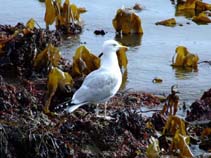Larus argentatus Pontoppidan, 1763
Herring gull
Classification / Names প্রচলিত নাম সমূহ | প্রতিনাম সমূহ | CoL | ITIS | WoRMS
Aves | Charadriiformes | Laridae
Environment: milieu / climate zone / গভীরতার পরিসীমা / distribution range বাস্তুসংস্থান
; স্বাদু পানি; ঈষৎ লোনা . Tropical; 84°N - 36°S, 130°W - 128°E (সূত্র 124582)
Distribution দেশ সমূহ | এফ এ ও এলাকাসমূহ | বাস্তুতন্ত্র | দৃষ্টিগোচর | প্রচলন
Indo-Pacific, Atlantic Ocean and the Arctic. Tropical to polar.
Length at first maturity / আকৃতি / Weight / Age
পরিপক্কতা : Lm ? range ? - ? cm Max length : 66.0 cm TL পুরুষ/ লিঙ্গ অনিধর্ারিত ; (সূত্র 8812); সবের্াচ্চ প্রকাশিত ওজন : 1.1 kg (সূত্র 356)
Short description বহিঃ অঙ্গ সংস্থান
Life cycle and mating behavior পরিপক্কতা | প্রজনন | ডিম ছাড়া | Eggs | ডিম্বধারন ক্ষমতা | Larvae
Main reference
সূত্র সংখ্যা | সমম্বয়কারী | সহযোগী
Stiles, F.G. 1984 Status and conservation of seabirds in Costa Rican waters. In Croxall, J.P., Evans, P.G.H. and Schreiber, R.W. (eds.), Status and Conservation of the World's Seabirds. ICBP Technical Publication 2:223-229. (সূত্র 5856)
IUCN Red List Status
(সূত্র 130435: Version 2025-1)
CITES status (সূত্র 108899)
CMS (সূত্র 116361)
Threat to humans
Human uses
| FishSource |
হাতিয়ার
আরো তথ্য
পরিপক্কতা
ডিম্বধারন ক্ষমতা
ডিম ছাড়া
Eggs
Egg development
Larvae
ইন্টারনেট সুত্র
BHL | BOLD Systems | CISTI | DiscoverLife | FAO(Publication : search) | Fishipedia | GenBank (genome, nucleotide) | GloBI | Gomexsi | Google Books | Google Scholar | Google | PubMed | জীবন বৃক্ষ | Wikipedia (Go, অনুসন্ধান ) | জুলজিকাল রেকর্ড



